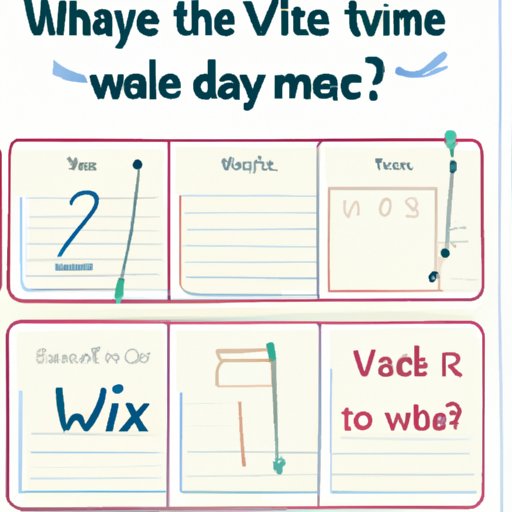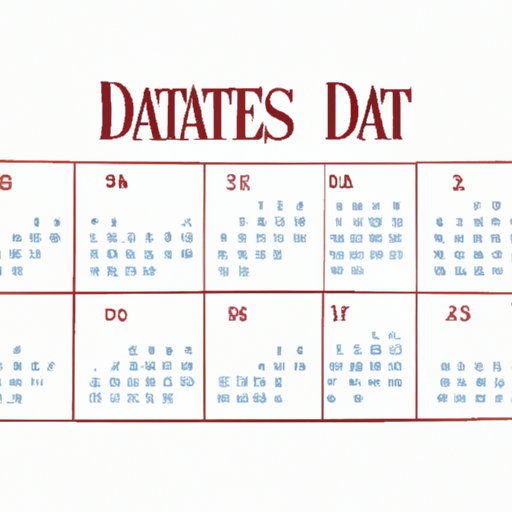I. Introduction
Do you ever find yourself struggling to write dates correctly? Do you get confused by the different formats used in different countries or regions? Writing dates accurately might seem simple, but it can be surprisingly complex. Whether you are writing a personal letter, a work email, or a professional document, getting the date right is essential for clarity and professionalism. In this article, we will explore everything you need to know about writing dates. From the basics of date formats to the history of date writing, we will cover it all. By the end of this guide, you will be able to write dates with confidence, accuracy, and style.
II. A Complete Guide on Writing Dates: Tips and Tricks for Accuracy
Dates can be written in many different formats, depending on the context and the location. Here are some of the most common date formats:
- Month/Day/Year (e.g., 08/23/2021)
- Day/Month/Year (e.g., 23/08/2021)
- Year/Month/Day (e.g., 2021/08/23)
- Month Day, Year (e.g., August 23, 2021)
- Day Month Year (e.g., 23 August 2021)
Each format can be used in different parts of the world, and can be influenced by cultural or historical factors. For instance, the United States tends to use the Month/Day/Year format, while Europe often uses the Day/Month/Year format. Japan typically uses the Year/Month/Day format. The Month Day, Year format is often used in North America, while the Day Month Year format is more common in countries such as the United Kingdom and Australia.
Here are some examples of each format:
- Month/Day/Year: 08/23/2021
- Day/Month/Year: 23/08/2021
- Year/Month/Day: 2021/08/23
- Month Day, Year: August 23, 2021
- Day Month Year: 23 August 2021
When choosing a date format, it is important to consider the context and audience. For instance, if you are writing a formal business letter, you may want to choose a format that is widely accepted in professional settings. On the other hand, if you are sending a casual email to friends or family, you may prefer a more personal or informal format. Whatever you choose, make sure to be consistent and clear in your writing.
III. How to Avoid Common Mistakes When Writing Dates
Even with the right format, it is easy to make mistakes when writing dates. Here are some common errors to watch out for:
- Mixing up the order of the month and day
- Using the wrong numeral format (e.g., using a comma instead of a slash)
- Forgetting to include the year
- Using abbreviations that are unclear or inconsistent (e.g., Sep. vs. Sept.)
- Writing the date in a different language or format than the intended audience
To avoid these mistakes, use the following tips:
- Write the month as a word instead of a number to avoid confusion (e.g., August instead of 08)
- Use the numeral format that is most common in your region or audience
- Include the year to avoid ambiguity (especially when writing in the future)
- Check your spelling and formatting for consistency
- When writing dates in a different format or language, double-check for accuracy and clarity.
IV. The Importance of Consistent Date Formatting in Professional Writing
Professional documents require consistent date formatting to ensure clarity and professionalism. Examples of documents that require consistent date formatting include:
- Resumes and cover letters
- Business plans and proposals
- Legal documents and contracts
- Academic papers and articles
- Government forms and applications
When writing these types of documents, it is important to choose a date format that is widely accepted in your field or region. Consistency in formatting also helps to avoid confusion or misinterpretation, ensuring that your message is clear and professional.
Here are some tips for achieving consistent date formatting:
- Choose a date format that is widely accepted in your field or region
- Use a style guide (such as APA, MLA, or Chicago) to ensure consistency
- Be aware of any company or organization-specific guidelines for date formatting
- Proofread your writing for consistency and accuracy.
V. Dates in History: An Exploration of the Evolution of Date Writing
Date writing has evolved throughout history, with different cultures and civilizations using unique systems to record time. Here are some historical examples:
- The ancient Egyptians used a calendar based on the cycles of the Nile River, with one year consisting of 365 days divided into 12 months of 30 days each and an additional 5 days at the end of the year.
- The ancient Greeks and Romans used a calendar system based on lunar cycles, with 12 months and a 13th intercalary month added periodically to bring the calendar back in line with the solar year.
- The Julian calendar, developed by Julius Caesar in 46 BC, standardized the length of the year to 365.25 days and introduced the concept of leap years.
- The Gregorian calendar, introduced by Pope Gregory XIII in 1582, further refined the Julian calendar by removing leap years in years divisible by 100 (with exceptions for years divisible by 400).
Today, the Gregorian calendar is widely used in most parts of the world, with variations in date formatting and local holidays.
VI. Mastering Dates in Your Writing: What Your Style Guide Wants You to Know
The specific rules for date writing can vary based on the style guide you are using. Here are some examples of date formatting based on common style guides:
- APA style: Month Day, Year (e.g., August 23, 2021)
- MLA style: Day Month Year (e.g., 23 August 2021)
- Chicago style: Month Day, Year (e.g., August 23, 2021) or Day Month Year (e.g., 23 August 2021)
When writing in a specific style, it is important to stick to the rules for consistency and professionalism. Here are some tips for choosing a style guide:
- Consider your audience and their expectations for professional writing
- Research the guidelines for each style guide and choose the one that best fits your needs
- Use online resources (such as Purdue’s OWL or the Chicago Manual of Style) to help you understand the rules
- Proofread your writing for accuracy and consistency.

VII. Fun Ways to Remember How to Write Dates
Writing dates accurately can be challenging, but it can also be fun! Here are some creative tips and tricks to help you remember the correct way to write dates:
- Create a mnemonic device (such as “My Very Elegant Mother Just Served Us Nachos” to remember the order of the planets)
- Use silly rhymes or songs to help remember specific dates (e.g., “Remember, remember, the fifth of November”)
- Practice writing dates in fun and engaging ways, such as writing them in different fonts or colors
- Quiz yourself or a friend on different date formats.
By making date writing a fun and memorable activity, you can improve your accuracy and confidence in writing dates.
VIII. Conclusion
Writing dates accurately is an essential skill for personal, professional, and academic writing. By understanding the different date formats, avoiding common mistakes, and achieving consistent date formatting, you can communicate your message clearly and professionally. Whether you are writing a simple email or a complex business proposal, taking the time to ensure accuracy and consistency in your date writing will help you stand out as a competent and professional writer.
